RARE ORIGINAL Dealer Store Catalog Leslie-Henry Toy Cap Guns 1950s Gene Autry
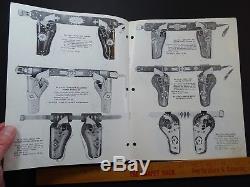
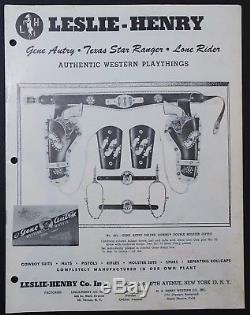
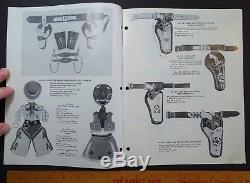
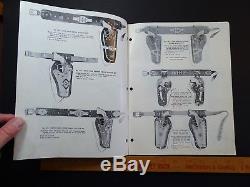
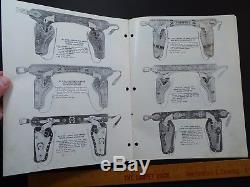
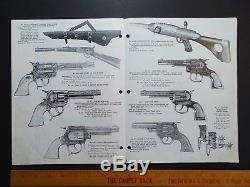
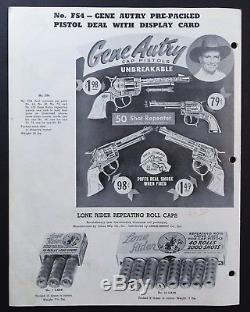


SUPER RARE Advertising Trade Catalog. DEALER - STORE Wholesale Catalog. For offer, a nice old trade catalog. Fresh from an estate in Upstate New York.
Never offered on the market until now. Vintage, Old, antique, Original - NOT a Reproduction - Guaranteed!! Spectacular - I have never seen this one before - very hard to find - I could not locate one anywhere.
Came from an old estate near Rochester, NY - I will be listing other catalogs from this estate. I Wish I Could have gotten the guns but someone else got them before I could get them. Gene Autry, Texas Star Ranger, Lone Ranger, "Authentic Western Playthings" - Western outfits, Cowboy suits, hats, pistols, rifles, holster sets, spurs, repeating roll caps / roll caps Lone Rider - Jatina Mfg.
Also shows an interesting repeating sky gun - looks like a cosmic ray gun. In very good condition - holes punched in left side edge - numbers / prices penciled in in some areas. Light soiling to a few pages. Please see photos for details. If you collect Americana history, American advertisement ad, diecast / cast toys, etc.
This is one you will not see again soon. A nice piece for your paper / ephemera collection.Perhaps some genealogy research information as well. A cap gun, cap pistol, or cap rifle is a toy gun that creates a loud sound simulating a gunshot and a puff of smoke when a small percussion cap is exploded. Cap guns were originally made of cast iron, but after World War II were made of zinc alloy, and most newer models are made of plastic.
Cap guns get their name from the small discs of shock-sensitive explosive compounds roughly 1.4 to 1.6 millimetres (0.055 to 0.063 in) in diameter that provide the noise and smoke, effectively the same as the Maynard tape primer and percussion caps used in real firearms of the mid to late 1800s but usually smaller and made from cheap plastic or paper. Some are arranged in plastic rings of eight or twelve. There are also single caps, roll caps (of 50 to 500), disk caps, and cap strips all of which are actually extremely small versions of percussion fireworks. Armstrong's mixture is often used today as the explosive, but previously the tiny powder charge was a simple mixture of potassium perchlorate, sulfur, and antimony sulfide sandwiched between two paper layers which hold in the gases long enough to give a sound report when the cap is struck. Cap guns first appeared following the end of the American Civil War in the mid-1860s, when firearms companies experimented with toy guns in order to stay in business.Cap guns became especially popular when the heroes of cinema and television rode through the West ridding the territories of villains. Many cap guns were named after or endorsed by leading matinee idols like Roy Rogers, Gene Autry, Hopalong Cassidy, The Lone Ranger, Tonto, Dale Evans, Marshal Matt Dillon, or any of countless others. A display of Nichols Industries cap guns.
Some collectors collect all brands. The "Golden Age" of cap guns was roughly a 20-year period following World War II when television became popular and such companies as Nichols, Hubley, Kenton, Kilgore, Wyandotte, Classy, Mattel, Actoy, Esquire, George Schmidt, and Stevens in the USA and companies like Lone Star Toys in the UK made millions of cap guns in various versions.
While many had their names patterned after a hero or heroine, many cap guns also were named with western-sounding names, like: "Stallion 45", "Pony", "Mustang", "Pioneer", "Cowboy", "Texan", "Colt 45", "Rodeo", and such. Children all over the world emulated their heroes and collected and played with these toy guns. There were many types of cap guns, including guns from small Derringers, to larger rifles, and even working miniatures of most of them.One of the last famous ones to sell widely was a toy rifle named after the television show, The Rifleman, which aired from 1958 through early 1963. Other shows lasted longer, such as Gunsmoke (which had 20 seasons lasting through 1975), but those did not have as much'kid-appeal' as the earlier shows, and the sales of toy cap guns began to decline.
The pistols generally were in 3 styles, the semi-automatic, the revolver (that actually had a revolving cylinder carrying a disk of caps) and the mock-revolver that looked like a regular revolver, but opened to load a roll of caps. Almost all of the early models used either roll caps or circular disks of caps, but in 1950 Nichols Industries came out with a large model called the Stallion 45, which had a revolving cylinder into which individual bullets were loaded, which each had two parts.The circular cap was placed into the 2-piece bullet and then when the gun was loaded and fired, it seemed more realistic. Eventually several companies used this idea and a few years later Nichols invented a plastic bullet that was snapped into a hollowed-out version of the regular 2-piece bullet with a compression spring inside. When the gun was fired, the spring pressure "shot" the plastic pellet out of the end of the barrel.
Eventually Mattel also came out with a similar model called Shootin' Shells. Mattel produced an automatic firing cap weapon styled after the Thompson submachine gun. Pulling back on a slide, which simulated the charging handle of the real Thompson, prepared the gun for firing by tensioning a spring. When the trigger was pulled the spring power would drive the mechanism, firing a series of up to ten caps from a sprocket-fed roll. It was made initially for a Dick Tracy line of toys, then camouflaged for a Green Beret Guerilla Fighter line of weapons, then restyled again as a tie-in with the Planet of the Apes franchise. Greenie Stick-M-Caps: Green peel-and-stick paper caps manufactured by the Mattel company to stick on the back of their "Shootin' Shells". Plastic, red circular discs used today.Containing gunpowder and a zinc alloy used to create a smaller explosion than would be previously reached with pure gunpowder components in the 1950s. Plastic strips, similar to disks, but arranged in a line, often with means of attaching singular strips to one another. Ring cap guns are usually modeled after revolver pistols, with the cap ring placed in the cylinder section of the toy gun. Like its real-world counterpart, when the trigger is pulled, the cylinder rotates a new cap into place, the hammer is drawn back, and then released; the shock causes the cap to explode harmlessly, producing the noise and smoke. Strip or paper cap guns use the aforementioned cap strip in lieu of the cap ring.
As in the ring style of gun, each pull of the trigger advances the cap strip forward, pulls back the hammer to the point where it releases, striking the cap. Potato or spud guns occasionally use a cap to provide a burst of gas to fire the projectile, a small cutting of potato. One design employs a small reusable metal "cartridge" which has a recess for a cap at one end and a small drilling through to the other end, which holds the potato.
Due to the low energy contained in a paper cap and the poor seal around the cartridge, these spud guns usually have very modest range, barely enough to eject the potato cutting. Mattel introduced a modified type of roll cap that used sprocket feed instead of simple friction feed. A modern cap gun, its barrel made from bright orange plastic to prevent it being mistaken for a real gun. Cap guns and other toy guns in the United States must be manufactured with a bright orange, red, or yellow tip placed over the "muzzle" of the cap gun, or with the entire gun made in these or other bright colours.
Laws requiring these markings were made because of incidents where children and teenagers were killed by police officers who mistook cap guns for real guns. While these incidents were rare, lawmakers decided that toy guns must be marked so they cannot be mistaken for real guns. [2] It is possible to be legally charged with armed robbery while using a replica gun, since no shots need to be fired from a gun that looks real. In July 2008 the U. Consumer Product Safety Commission banned toy caps producing peak sound levels at or above 138 decibels. [citation needed] Caps that would once have banged and smoked now pop at a low sound level. The purpose of this law is to protect childrens hearing. Caps have occasionally been used in toys other than cap guns where an explosive effect is desired.One example would be the "Thunder Punch" version of the He-Man action figure from the original 1980s Masters of the Universe toy line. Ring caps were placed in a "backpack" integrated into the figure, which contained the striking mechanism for the caps (as well as tiny vents to allow smoke from a triggered cap to escape). This mechanism was triggered by drawing the figure's spring-loaded right arm back and releasing it to swing forward; the explosion of the cap was intended to simulate a thunderous noise caused by the superhuman power of the character's punch. Similar cap firing mechanisms for toy soldiers were produced in Germany for the Elastolin and Lineol toy soldiers and artillery pieces. Another example is a relatively new type of Airsoft, called Hybrid Guns.
Hybrid guns use small round BBs in the tip of a casing, usually designed to mimic that of its respective magazine. The caps are placed behind the casing. In electric models, the caps are burst, and the pressure is used to propel the BB forward in a manner similar to real firearms.
The leftover energy is then sometimes put to use simulating recoil and a blowback system that ejects the casings. Also, caps are used in Chinese toy flare guns. The cap propels one or two pyrotechnic star loads in flare cartridge (firearms).Another use is in so-called "cap bombs"; devices roughly in the shape of an aerial bomb that contain a firing mechanism in the nose capable of holding a single cap, either plastic or paper (cut from a strip), though types are not interchangeable due to the mutually exclusive design. With the newer designs they have both the paper cap or plastic cap. When dropped on a hard surface, the impact detonates the cap. Another use is in "exploding pens" which are devices that look like ink pens but these contain an anvil where the explosive cap is placed, then a spring-loaded lever is pulled back and held in place by the cap of the pen. The pen is then ready to leave around or given to another person as a practical joke.
When an unsuspecting person pulls the cap of the pen off, the spring drives the lever against the explosive cap for a surprise bang. Orvon Grover "Gene" Autry[1] (September 29, 1907 October 2, 1998) was an American singer-songwriter, actor, musician, rodeo performer and business tycoon who gained fame as a singing cowboy in a crooning style on radio, in movies, and on television for more than three decades beginning in the early 1930s.
Autry was the owner of a television station, several radio stations in Southern California, and the Los Angeles/California/Anaheim Angels Major League Baseball team from 1961 to 1997. From 1934 to 1953, Autry appeared in 93 films, and between 1950 and 1956 hosted The Gene Autry Show television series. During the 1930s and 1940s, he personified the straight-shooting herohonest, brave, and trueand profoundly touched the lives of millions of Americans. [2] Autry was also one of the most important pioneering figures in the history of country music, considered the second major influential artist of the genre's development after Jimmie Rodgers.[2] His singing cowboy movies were the first vehicle to carry country music to a national audience. Autry was a member of both the Country Music Hall of Fame and Nashville Songwriters Hall of Fame, and is the only person to be awarded stars in all five categories on the Hollywood Walk of Fame, for film, television, music, radio, and live performance.
[3] The town of Gene Autry, Oklahoma was named in his honor. Orvon Grover Autry was born September 29, 1907 near Tioga in Grayson County in north Texas, the grandson of a Methodist preacher. His parents, Delbert Autry and Elnora Ozment, moved in the 1920s to Ravia in Johnston County in southern Oklahoma. He worked on his father's ranch while at school.
After leaving high school in 1925, Autry worked as a telegrapher for the St. His talent at singing and playing guitar led to performing at local dances. While working as a telegrapher, Autry would sing and accompany himself on the guitar to pass the lonely hours, especially when he had the midnight shift. This later got him fired. One night, he was encouraged to sing professionally by a customer, the famous humorist Will Rogers, who had heard him singing. According to Nathaniel Shilkret, [8] director of Light Music for Victor at the time, Autry asked to speak to Shilkret when Autry found that he had been turned down. Shilkret explained to Autry that he was turned down not because of his voice, but because Victor had just made contracts with two similar singers. Autry left with a letter of introduction from Shilkret and the advice to sing on radio to gain experience and to come back in a year or two. In 1928, Autry was singing on Tulsa radio station KVOO (now KFAQ) as "Oklahoma's Yodeling Cowboy". The Victor archives[9] show an October 9, 1929 entry stating that the vocal duet of Jimmie Long and Gene Autry with two Hawaiian guitars, directed by L.Watson, recorded "My Dreaming of You" (Matrix 56761) and "My Alabama" (Matrix 56762). Autry signed a recording deal with Columbia Records in 1929. In his early recording career, Autry covered various genres, including a labor song, "The Death of Mother Jones", in 1931.
Autry also recorded many "hillbilly"-style records in 1930 and 1931 in New York City, which were certainly different in style and content from his later recordings. These were much closer in style to the Prairie Ramblers or Dick Justice, and included the "Do Right, Daddy Blues" and "Black Bottom Blues", both similar to "Deep Elem Blues". These late Prohibition-era songs deal with bootlegging, corrupt police, and women whose occupation was certainly vice. These recordings are generally not heard today, but are available on European import labels, such as JSP Records.
His first hit was in 1932 with "That Silver-Haired Daddy of Mine", a duet with fellow railroad man, Jimmy Long, which Autry and Long co-wrote. Autry also sang the classic Ray Whitley hit "Back in the Saddle Again", [10] as well as many Christmas holiday songs, including "Santa Claus Is Coming to Town", his own composition "Here Comes Santa Claus", "Frosty the Snowman", and his biggest hit, "Rudolph the Red-Nosed Reindeer". He wrote "Here Comes Santa Claus" after being the Grand Marshal of the 1946 Santa Claus Lane Parade (Now the Hollywood Christmas Parade). He heard all of the spectators watching the parade saying Here comes Santa Claus! Virtually handing him the title for his song. He recorded his version of the song in 1947 and it became an instant classic.Autry was the original owner of Challenge Records. The label's biggest hit was "Tequila" by The Champs in 1958, which started the rock-and-roll instrumental craze of the late 1950s and early 1960s. Autry made 640 recordings, including more than 300 songs written or co-written by himself.
Gene Autry in Oh, Susanna! Autry and Burnette were discovered by film producer Nat Levine in 1934. Together, Autry and Burnette made their film debut for Mascot Pictures Corp.
In In Old Santa Fe as part of a singing cowboy quartet; he was then given the starring role by Levine in 1935 in the 12-part serial The Phantom Empire. Shortly thereafter, Mascot was absorbed by the newly formed Republic Pictures Corp. And Autry went along to make a further 44 films up to 1940, all B Westerns in which he played under his own name, rode his horse, Champion, had Burnette as his regular sidekick, and had many opportunities to sing in each film. Buttram would co-star with Gene Autry in more than 40 films and in over 100 episodes of Autry's television show. Gene Autry in The Gene Autry Show episode "The Black Rider", 1950.
[11] He appeared in the similar Box Office poll from 1936 to 1955, holding first place from 1936 to 1942 and second place (after Rogers) from 1943 to 1952. Gene Autry was the first of the singing cowboys in films, but was succeeded as the top star by Roy Rogers while Autry served in the AAF during World War II. He appeared in 1951 in the film Texans Never Cry, with a role for newcomer Mary Castle.
After 1951, Autry formed his own production company to make Westerns under his own control, which continued the 1947 distribution agreement with Columbia Pictures. He renamed it the Melody Ranch after his movie Melody Ranch. The Western town, adobes, and ranch cabin sets and open land for location shooting were retained as a movie ranch on 12 acres. However, the devastated landscape did prove useful for productions such as Combat!
A complete adobe ranch survived at the northeast section of the ranch. In 1990, after his favorite horse Champion, which lived in retirement there, died, Autry put the remaining 12-acre ranch up for sale. It is now known as the Melody Ranch Motion Picture Studio and Melody Ranch Studios on 22 acres. [18] The ranch has Melody Ranch Museum open year-round; and one weekend a year, the entire ranch is open to the public during the Cowboy Poetry and Music Festival, another legacy of Autry's multiple talents. Gene Autry with the Pinafores, who sang on his weekly radio show, 1948. From 1940 to 1956, Autry had a huge hit with a weekly show on CBS Radio, Gene Autry's Melody Ranch.His horse, Champion, also had a CBS-TV and Mutual radio series, The Adventures of Champion. In response to his many young radio listeners aspiring to emulate him, Autry created the Cowboy Code, or Ten Cowboy Commandments.
These tenets promoting an ethical, moral, and patriotic lifestyle that appealed to youth organizations such as the Boy Scouts, which developed similar doctrines. The Cowboy Code consisted of rules that were a natural progression of Gene's philosophies going back to his first Melody Ranch programsand early pictures. [21] According to the code. The Cowboy must never shoot first, hit a smaller man, or take unfair advantage. He must never go back on his word, or a trust confided in him.
He must always tell the truth. He must be gentle with children, the elderly, and animals.
He must not advocate or possess racially or religiously intolerant ideas. He must help people in distress. He must be a good worker. He must keep himself clean in thought, speech, action, and personal habits. He must respect women, parents, and his nation's laws.The Cowboy is a patriot. Beginning in 1950, he produced and starred in his own television show on CBS through his Flying A Productions studio and made several appearances on ABC-TV's Jubilee USA in the late 1950s. During World War II, Autry enlisted in the United States Army in 1942, and became a tech sergeant in the United States Army Air Forces. Assigned to a unit of the Air Transport Command, he flew as part of the dangerous airlift operation over the Himalayas between India and China, nicknamed the Hump.
Gene Autry and Gail Davis in Toronto, circa 1956. Few are aware of Autry's longtime involvement in professional rodeo. In 1942, at the height of his screen popularity, Autry had a string of rodeo stock based in Ardmore, Oklahoma. A year later, he became a partner in the World Championship Rodeo Company, which furnished livestock for many of the country's major rodeos.
In 1954, he acquired Montana's top bucking string from the estate of Leo J. And put Canadian saddle bronc riding champion Harry Knight in charge of the operation. A merger with the World Championship Rodeo Company in 1956 made Autry the sole owner. He moved the entire company to a 24,000-acre (97 km2) ranch near Fowler, Colorado, with Knight as the working partner in the operation. For the next 12 years, they provided livestock for most of the major rodeos in Texas, Colorado, Montana, and Nebraska. For his work as a livestock contractor, Autry was inducted into the Professional Rodeo Cowboys Association's ProRodeo Hall of Fame in 1979. [25] Autry actually received several honors for his contributions to rodeo. 1972 Great Western Performers of the National Cowboy and Western Heritage Museum[26]. 1979 ProRodeo Hall of Fame[25]. 1980 Hall of Great Westerners of the National Cowboy and Western Heritage Museum[27]. 1988 Texas Trail of Fame[28].2013 Texas Rodeo Cowboy Hall of Fame[29]. Autry retired from show business in 1964, having made almost 100 films up to 1955 and over 600 records.
He was elected to the Country Music Hall of Fame in 1969 and to the Nashville Songwriters Hall of Fame[30] in 1970. After retiring, he invested widely and in real estate, radio, and television. He also invested in ownership of the KOOL-TV CBS-affiliate in Phoenix, Arizona, which created local shows such as the weekly bilingual children's show Ninos Contentos. In 1952, Autry bought the old Monogram Ranch in Placerita Canyon (Newhall-Santa Clarita, California,) and renamed it Melody Ranch.
Numerous "B" Westerns and TV shows were shot there during Autry's ownership, including the initial years of Gunsmoke with James Arness. Melody Ranch burned down in 1962, dashing Autry's plans to turn it into a museum.
According to a published story by Autry, the fire caused him to turn his attention to Griffith Park, where he would build his Museum of Western Heritage (now known as the Autry National Center). It survives as a movie location today, as well as the home of the City of Santa Clarita's annual Cowboy Festival, where Autry's legacy takes center stage. Gene Autry's number 26 was retired by the California Angels in 1992.
In the 1950s, Autry had been a minority owner of the minor-league Hollywood Stars. In 1960, when Major League Baseball announced plans to add an expansion team in Los Angeles, Autrywho had once declined an opportunity to play in the minor leaguesexpressed an interest in acquiring the radio broadcast rights to the team's games. Baseball executives were so impressed by his approach that he was persuaded to become the owner of the franchise rather than simply its broadcast partner. The team, initially called the Los Angeles Angels upon its 1961 debut, moved to suburban Anaheim in 1966, and was renamed the California Angels, then the Anaheim Angels from 1997 until 2005, when it became the Los Angeles Angels of Anaheim.Autry served as vice president of the American League from 1983 until his death. The number 26 (as in 26th man) was retired by the Angels in Autry's honor.
The chosen number reflected that baseball's rosters are 25-man strong, so Autry's unflagging support for his team made him the 26th member (see also the 12th man, a similar concept in football). Grave of Gene Autry, at Forest Lawn Hollywood Hills. Gene Autry died of lymphoma on October 2, 1998, three days after his 91st birthday at his home in Studio City, California. He was buried at the Forest Lawn, Hollywood Hills Cemetery in Los Angeles.[31] His epitaph read, America's Favorite Cowboy... American Hero, Philanthropist, Patriot and Veteran, Movie Star, Singer, Composer, Baseball Fan and Owner, 33rd Degree Mason, Media Entrepreneur, Loving Husband, Gentleman. In 1932, Autry married Ina May Spivey, the niece of Jimmy Long. After she died in 1980, he married Jacqueline Ellam, who had been his banker, in 1981. He had no children by either marriage.
Autry was raised into Freemasonry in 1927 at Catoosa Lodge No. He later became a 33rd degree Master Mason, as recorded on his headstone. On November 16, 1941, the town of Berwyn, Oklahoma, north of Ardmore, was renamed in honor of Gene Autry. In 1972, he was inducted into the Western Performers Hall of Fame at the National Cowboy & Western Heritage Museum in Oklahoma City, Oklahoma.
Autry was a life member of the Benevolent and Protective Order of Elks, Burbank Lodge No. His 1976 autobiography, co-written by Mickey Herskowitz, was titled Back in the Saddle Again after his 1939 hit and signature tune.
He is also featured year after year, on radio and "shopping mall music" at the holiday season, by his recording of Rudolph the Red-Nosed Reindeer. " "Rudolph became the first No. 1 hit of the 1950s. In 2003, he was ranked No. 38 in CMT's list of the 40 Greatest Men of Country Music. When the Anaheim Angels won their first World Series in 2002, much of the championship was dedicated to him. The interchange of Interstate 5 and State Route 134, near the Autry National Center in Los Angeles, is signed as the Gene Autry Memorial Interchange. In 2007, he became a charter member of the Gennett Records Walk of Fame in Richmond, Indiana. Johnny Cash recorded a song in 1978 about Autry called Who is Gene Autry? " Cash also got Autry to sign his famous black Martin D-35 guitar, which he plays in the video of "Hurt.In 1977, Autry was awarded the American Patriots Medal by Freedoms Foundation of Valley Forge, Pennsylvania. Other winners of this medal were Helen Hayes, John Wayne, and Texas State Representative Clay Smothers.
Autry was inducted into the Radio Hall of Fame in 2003. In 2004, the Starz Entertainment Corporation joined forces with the Autry estate to restore all of his films, which have been shown on Starz's Encore Western Channel on cable television on a regular basis to date since. Autry was inducted into the Oklahoma Hall of Fame in 1991. Autry is the only person to have five stars on the Hollywood Walk of Fame, one in each of the five categories defined by the Hollywood Chamber of Commerce.
[35] All of Autry's stars are located along Hollywood Boulevard: Recording at 6384, Radio at 6520, Motion pictures at 6644, Television at 6667, and Live theatre at 7000 Hollywood Boulevard. His first four stars were placed during the initial inductions of 1960 while the final one was placed in 1987, in the additional category named "Live theatre"later renamed "Live performance"introduced in 1984. The Museum of the American West. The Museum of the American West in Los Angeles' Griffith Park was founded in 1988 as the Gene Autry Western Heritage Museum, featuring much of his collection of Western art and memorabilia. It is now called The Autry National Center and is divided into two locations, eight miles apart from each other.
Its mission is to present the unique and diverse perspectives of the American West, including the romanticized West in pop culture and the "real" nuanced history, including native and minority voices. South of the Border, All American Cowboy."A Face I See at Evening". "That Silver-Haired Daddy of Mine" (w/ Jimmy Long). "Take Me Back to My Boots and Saddle". "Gold Mine in the Sky".
"Back in the Saddle Again". "You Are My Sunshine"[38]. "I'm Thinking Tonight of My Blue Eyes". "I Hang My Head and Cry".
"Gonna Build a Big Fence Around Texas". "Don't Fence Me In". "Don't Hang Around Me Anymore". "I Want to Be Sure". "Don't Live a Lie".
"Silver Spurs (On the Golden Stairs)". "I Wish I Had Never Met Sunshine"."Wave to Me, My Lady". "You Only Want Me When You're Lonely".
Have I Told You Lately that I Love You? "Someday (You'll Want Me to Want You)".
"You're Not My Darlin' Anymore". "Here Comes Santa Claus (Down Santa Claus Lane)". "Here Comes Santa Claus (Right Down Santa Claus Lane)".
"Ghost Riders in the Sky". "Rudolph the Red-Nosed Reindeer" (w/ The Pinafores). Denotes releases that did not chart. "Frosty the Snow Man" (w/ The Cass County Boys).
"Nobody's Darlin' but Mine". "Rudolph the Red-Nosed Reindeer" (re-entry). Main article: Gene Autry filmography. From 1934 to 1953, Gene Autry appeared in 93 films.
[40][Note 1] From 1950 to 1955, he also appeared in 91 episodes of The Gene Autry Show television series. [41][42] As of 2014, a large number of these films and television episodes remain available via the Gene Autry Foundation on the Western Channel (a cable television station), the latter having collaborated with the Foundation to restore the Republic titles, which had been cut to a uniform 54 minutes for television release in the 1950s, to full length and to provide clean negative-based source prints for all the titles in the 1990s. In Old Santa Fe (1934). The Phantom Empire (1935) (serial). Comin' Round the Mountain (1936). Round-Up Time in Texas (1937). Git Along Little Dogies (1937).Yodelin' Kid from Pine Ridge (1937). Springtime in the Rockies (1937). The Old Barn Dance (1938). Gold Mine in the Sky (1938). Man from Music Mountain (1938).
Rhythm of the Saddle (1938). Home on the Prairie (1939). South of the Border (1939). Ridin' on a Rainbow (1941).Back in the Saddle (1941). Heart of the Rio Grande (1942). Stardust on the Sage (1942).
Call of the Canyon (1942). Trail to San Antone (1947). Twilight on the Rio Grande (1947). Robin Hood of Texas (1947). Riders of the Whistling Pines (1949).Rim of the Canyon (1949). The Cowboy and the Indians (1949). Riders in the Sky (1949). Sons of New Mexico (1949).
Beyond the Purple Hills (1950). Gene Autry and the Mounties (1951). The Hills of Utah (1951). Night Stage to Galveston (1952).
Winning of the West (1953). On Top of Old Smoky (1953). Last of the Pony Riders (1953). Autry National Center of the American West. This replica gun contains the colored markings required by law, including a permanently attached orange plug. The item "RARE ORIGINAL Dealer Store Catalog Leslie-Henry Toy Cap Guns 1950s Gene Autry" is in sale since Wednesday, March 21, 2018. This item is in the category "Toys & Hobbies\Vintage & Antique Toys\Cap Guns\Other Vintage Cap Guns". The seller is "dalebooks" and is located in Rochester, New York.This item can be shipped to United States.
- Brand: Leslie-Henry
- Country/Region of Manufacture: United States
- Year: 1955


